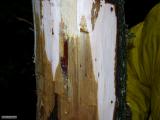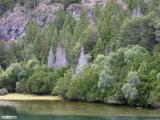Disease
High levels of mortality of A. chilensis trees were reported in 1948 in Isla Victoria in Nahuel Huapi National Park, in Patagonia, Argentina, near plantings of exotic trees collected from around the world. In 1953, similar mortality was reported in an Austrocedrus stand located near a forest nursery in Epuyen, about 150 km distant from Isla Victoria. Since then, mortality has been reported in many places throughout the range of A. chilensis on the eastern slopes of the Andes in Argentina. In all cases, it has been assumed that the cause was the disease named mal del ciprés (MDC, cypress sickness) (Havrylenko et al. 1989). Although Phytophthora was suspected as a causal agent, no successful isolations were reported until 2007.
In Argentina Austrocedrus chilensis grows across a broad moisture gradient along the Andean foothills. A. chilensis can be found either in mixed stands with Nothofagus spp. or in pure Austrocedrus stands on drier sites. It also grows in open, xeric forests or in isolated clumps at the limit of the Andean forest and the Patagonian steppe, acting as a barrier against desert advance. Austrocedrus chilensis is valued not only because of its ecological function but because of the quality of its wood and its scenic importance (Greslebin et al. 2010). It is a protected species, with harvest strictly regulated by the state.
MDC is associated with specific site conditions at both microsite and landscape scales (La Manna et al. 2008), particularly high soil moisture and poor drainage (Baccala´ et al. 1998, Filip & Rosso 1999, La Manna & Rajchenberg 2004). Tree death tends to occur in clusters in forest stands, at least when disease incidence is low (Rosso et al. 1994).
Concern about the disease has increased due to the constant expansion of the affected area. The disease affects tourism, recreation and commercial forestry. Appropriate silvicultural management of affected stands is difficult because the epidemiology of the disease is poorly understood. Public institutions in charge of forest management have authorized land owners with affected forests to fell the dead trees, which has had the serious consequence of the replacement of native forest with exotic introduced species. (Greslebin et al. 2010).
In Argentina, Austrocedrus chilensis is the only known host of P. austrocedrae. The susceptibility of other species is largely untested. The North American incense cedar (Libocedrus decurrans) is very similar to Austrocedrus, both in appearance and ecologically. Its susceptibility has not been tested.
The main symptom of P. austrocedrae in naturally infected trees is a necrotic lesion extending from killed roots up to 1 m high on the tree bole. The necrosis affects the entire thickness of the phloem and the sapwood is superficially stained. Both active and inactive lesions are encountered. When active, lesions are bright chestnut brown, moist and flexible. When inactive, they are dark brown, dry and hard, and difficult to distinguish from the outer bark. Defoliation is associated with the amount of root affected, but it is not totally reliable as an indicator of the percentage of necrotic tissues of main roots and root collar (Floria & Greslebin 2009). Sometimes, especially in stands where the disease is very active, older foliage inside the crown turns bright yellow and then red by the end of the summer. This symptom is usually associated with the presence of active lesions at the root collar. Resin exudation is often associated with Phytophthora lesions. Resin flow usually emerges from a resin pocket in the phloem near the activemargin of a lesion.
| Host Latin Name | Host Common Name | Symptoms | Habitat | Region | |
|---|---|---|---|---|---|
| Austrocedrus chilensis | Chilean cedar | Canker, Decline | Forest | Argentina |




